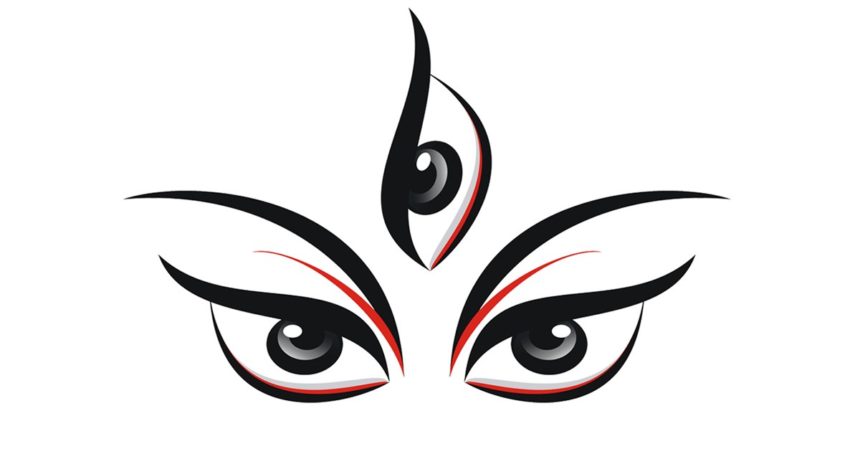Rakta Chamunda blends the fierce and the peaceful in her personality, thus reflecting aspects of both Kali and Lalita.
A Goddess who is both Kali and Sri

My wife Pratyasha, who is a painter decided a few months ago to create a painting of a Hindu Goddess. She approached me with her idea and asked me to suggest a form of the Goddess. Her only condition was that the deity should be unique, relatively not well known, and the iconographical features should be both attractive to the lay devotee and insightful and introspective for those with a philosophical bent.
Taking this as a challenge, I began to pore over the meditative verses, the Dhyana mantras, of a large number of Hindu deities, which describe their iconographical details. The task was particularly difficult since Hinduism is a decentralized religious and spiritual tradition that facilitates the worship of innumerable deities: Gods and Goddesses, who are considered different manifestations of one underlying reality-Brahman. These diverse paths offer tailor-made spiritual solutions to every individual based on his or her individual temperament and competencies and facilitate him/her to attain self-actualization and eventually, even self-realization.
Finally, after much searching through many books, I landed upon one unique deity, who would be both attractive to the eyes and stimulating to the intellect and who held deep meaning and symbolism, not only in terms of philosophy but also in terms of iconography and practical worship. Such a deity was “Rakta Chamunda”, whose iconographical details have been mentioned in Tantric texts like “Prapanchasara”.
Chamunda is a special epithet of Goddess Kali and the name relates to the legend wherein Kali killed two demons Chanda and Munda. Kali in Sanskrit means “Black” or “Time” and as the name denotes she is Black in color. But, in her manifestation as Rakta Chamunda, her body has a Red complexion (Rakta=blood, i.e. red), a color, which is deeply associated with Goddess Sri or Lalita, also called as Tripurasundari.
In a highly diverse tradition of Goddess worship in India, Kali stands at the one extremity and Sri, at the other, with all other Goddesses occupying a place somewhere between these two extremities of the spectrum. While Kali represents a fierce (Ugra) aspect of the divine, Sri represents the peaceful (Shanta) aspect. While Kali is the embodiment of detachment and renunciation, Sri personifies abundance and fulfillment. The distinction is apparent even in the manner of their worship. Kali is best worshipped on a new moon night, while Sri is best worshipped on a full moon night. Similarly, the path of Kali takes one to the ultimate goal by freeing one from fear and other human weaknesses, often in a fierce manner; and the path of Sri takes one to the same ultimate goal by slowly unfolding the layers of ignorance that binds one to those weaknesses.
Despite such huge differences in the name, form, and nature of the two deities, as well in the medium of their worship, the two deities are but two faces of the same Divine Reality and this is best represented in the iconography of the Goddess Rakta Chamunda, who despite being a special manifestation of Kali, has an appearance and iconographical details, which match those of Sri.
Pratyasha, who loved the suggestion of painting Rakta Chamunda, immediately commenced creating the artwork and finished it within two weeks. The painting depicts the deity in a colorful and attractive manner using the style known as “Traditional Mysore Style”, all the while adhering to the details mentioned in the meditative verse of Rakta Chamunda, as given in Prapanchasara.
The unique feature of a Mysore Style painting is its 3-dimensional effect and the use of real gold in the ornaments. The ornamental areas are embossed and thin sheets of 22-carat gold are glued to them, thus giving a 3-dimensional effect to the entire painting. This 3-dimensional effect makes the deity in the painting come alive and enriches the experience of those who see, observe, and meditate on the image. After all, from the Indian perspective of art, the goal of painting a deity is to help spiritual seekers recreate the image of the deity inside their own minds by using external depictions as props for meditation.
Prapanchasara describes the Goddess as having a red complexion, wearing a yellow clothing and having a crescent moon as an ornament on the head. She has two hands, which holds a bow of sugarcane and an arrow, denoting desires and the mind. The text further says that she is smiling, has a beautiful navel, and is the destroyer of the enemies.
The text, thus, portrays both the peaceful and fierce aspect of the Goddess. The painting brings out this apparently contradictory features by depicting the fierce aspect of the deity through her serious and deep facial features, red body complexion, and the dark background, while the peaceful aspects are depicted through the relaxed posture called “Sukhasana” and a curt smile on the deity’s face.
Rakta Chamunda is thus a beautiful Goddess, who is yet fierce, denoting her identity with Kali, while her complexion, as well as the objects held in her hands, denote her identity with Sri. She is thus both “Chamunda, who has red complexion” and “the red Sri, who has Chamunda as her name”.
Editor’s Note: The painting of Mother Rakta Chamunda by Pratyasha can be seen and bought in digital format here

Leave a Reply